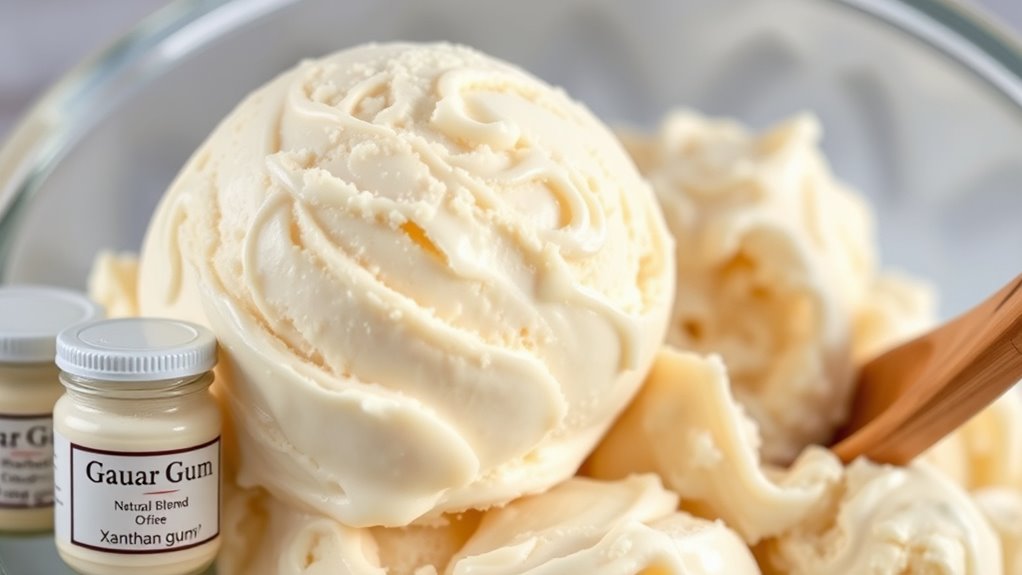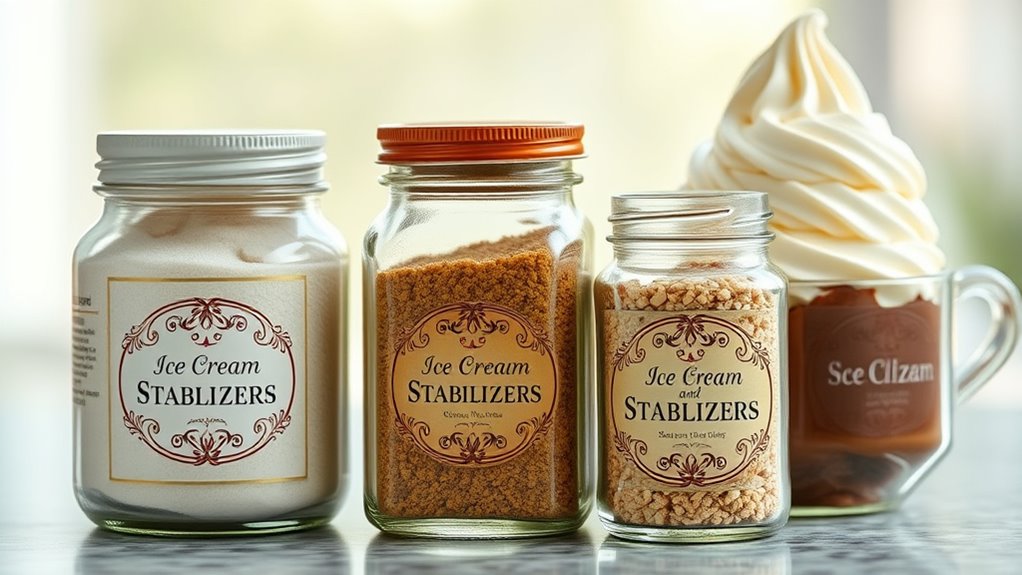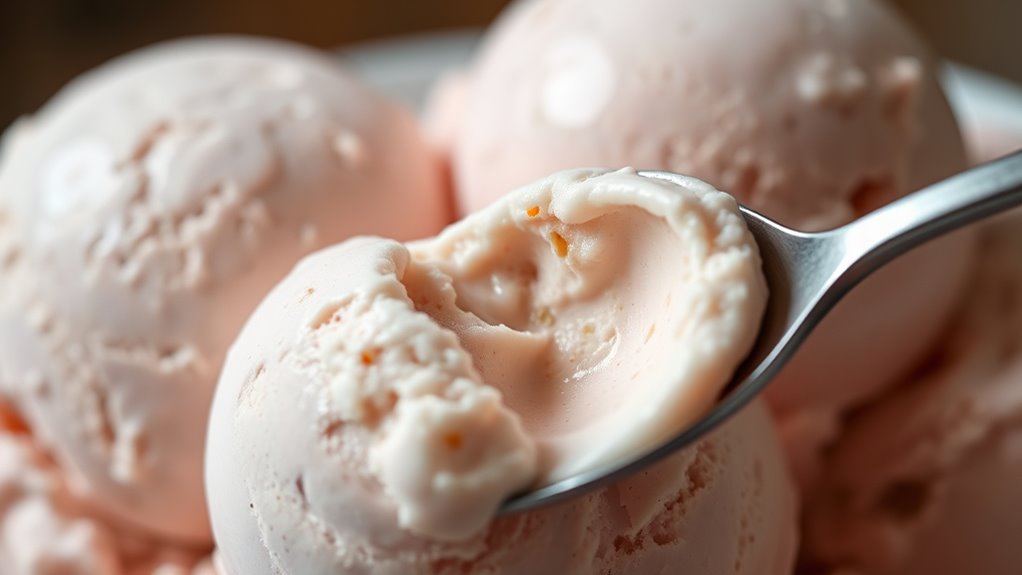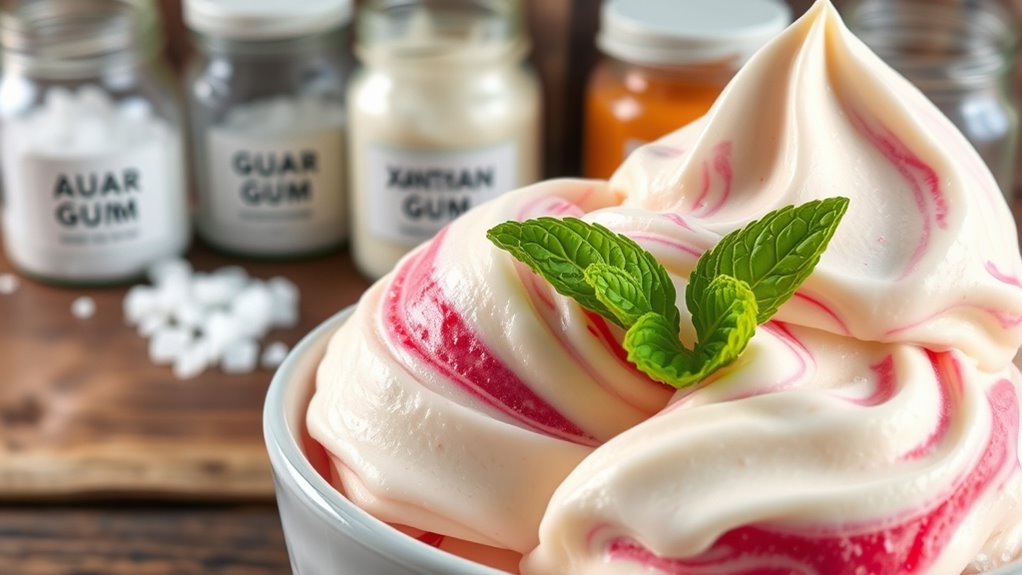Using stabilizers in ice cream helps create a creamier texture and prevents ice crystals from forming, ensuring smoothness. Guar gum, locust bean gum, and xanthan gum are popular choices. To use them, measure 0.2% to 0.5% of your total mix weight, and mix them into the liquid to avoid clumping. Proper hydration is key, as some require heating. So, if you want to enhance your ice cream’s quality, there’s more to discover about stabilizers and their benefits.
Key Takeaways
- Stabilizers enhance ice cream texture by increasing viscosity and creaminess, ensuring a smoother mouthfeel.
- They prevent ice crystal growth, maintaining a uniform and creamy consistency during temperature changes.
- Common stabilizers include Guar Gum, Locust Bean Gum, and Xanthan Gum, each with specific hydration requirements.
- Proper measurement between 0.2% to 0.5% of the total mix weight is crucial for achieving optimal results.
- Correctly used stabilizers improve flavor delivery and overall sensory experience without compromising quality.
The Role of Stabilizers in Ice Cream

When you indulge in a scoop of ice cream, stabilizers play an important role in creating that delightful experience.
These ingredients, like guar gum and locust bean gum, increase the viscosity of ice cream mixes, enhancing creaminess and improving texture. By preventing the growth of ice crystals, stabilizers guarantee your treat remains smooth and enjoyable, even during temperature fluctuations. Many ice cream flavors, like Birthday Cake Ice Cream, benefit from the creaminess that stabilizers provide.
Stabilizers like guar gum enhance ice cream’s creaminess, ensuring a smooth texture and preventing ice crystal growth.
They also slow down the melting process, helping the ice cream retain its shape and consistency longer. Properly used stabilizers mitigate shrinkage and wheying off, preserving quality.
With a typical usage rate of 0.2% to 0.5% of the total mix weight, carefully measuring stabilizers is vital to avoid undesirable textures and maintain that perfect creamy delight you crave. Additionally, understanding the healthiest fruit juice varieties can inspire unique flavor combinations that pair beautifully with your ice cream creations.
Types of Stabilizers Used in Ice Cream

Several types of stabilizers are commonly used in ice cream to enhance texture and prevent ice crystal formation.
Guar Gum is a popular choice, boosting stability without needing heat.
Locust Bean Gum requires heating to 185°F for ideal hydration, effectively reducing ice crystal growth while adding medium viscosity.
Xanthan Gum is versatile, improving texture but should be used carefully to avoid a slimy mouthfeel.
Pectin is often included in fruit-flavored ice creams for its gelling abilities, providing a delightful creamy consistency.
Additionally, stabilizers are typically blended at a dosage of 0.2-0.5% of the total mixture weight to achieve the best texture and stability in your ice cream formulations.
Choose your stabilizers wisely for the perfect scoop!
How to Measure and Hydrate Stabilizers

Accurate measurement and proper hydration of stabilizers are fundamental for achieving the perfect ice cream texture. You’ll want to measure stabilizers between 0.1% and 0.5% of your base mixture weight. Use precise scales that can measure to 0.1g or 0.01g for accuracy. Proper dispersion is essential to prevent clumping; gradually mix the stabilizers into the liquid.
| Stabilizer | Hydration Method |
|---|---|
| Guar Gum | Room temperature, monitor time |
| Locust Bean Gum | Heat to 185°F (85°C) |
| Other Stabilizers | Varies, check specific needs |
Monitoring temperature and water absorption is crucial for effective thickening. Make sure you understand how each stabilizer hydrates to achieve the best results.
Effects of Stabilizers on Texture and Quality

Stabilizers play an essential role in enhancing the texture and quality of ice cream, ensuring a satisfying experience with every scoop.
By increasing the viscosity of your ice cream mix, stabilizers like guar gum and locust bean gum create a creamy texture and improve mouthfeel. They suppress ice crystal growth, preventing large ice crystals from forming during storage, which helps maintain smoothness and uniformity.
Stabilizers like guar gum and locust bean gum enhance ice cream’s creaminess and prevent ice crystal growth for a smooth, uniform texture.
With the right balance, stabilizers also enhance flavor delivery, making flavors more pronounced and enjoyable.
However, be cautious—over-stabilization can lead to undesirable textures like gumminess or chewiness. Proper measurement and usage are key to achieving that perfect creamy texture without compromising quality.
Addressing Common Concerns About Stabilizers

While it’s easy to be skeptical about stabilizers in ice cream, understanding their role can change your perspective. Proper usage of stabilizers like guar gum and xanthan gum considerably reduces ice crystal growth, resulting in a smoother, creamier texture.
Many misconceptions arise from experiences with over-stabilized commercial ice creams, which can lead to undesirable chewiness or gumminess. However, when measured and hydrated correctly, stabilizers enhance mouthfeel and overall quality.
You don’t have to avoid them altogether; high-quality ice cream can benefit from the right stabilizers, especially during distribution. So, embrace stabilizers for their ability to improve sensory properties without sacrificing the ice cream experience you love. Additionally, incorporating low-carb options can help create a healthier version of your favorite treat without compromising on texture.
Frequently Asked Questions
How to Use Stabilizer in Ice Cream?
To use a stabilizer in ice cream, first measure it accurately, aiming for 0.1% to 0.5% of your mixture’s weight.
Disperse it evenly to avoid clumps, and hydrate according to its needs—some require heat while others don’t.
You can mix different stabilizers for better texture.
Throughout the freezing process, keep an eye on the texture and adjust the ratios if necessary to get that perfect creaminess and mouthfeel you want.
What Is the Function of Stabilizers?
Stabilizers are like magic potions for your ice cream! They turn your mix into a creamy dream, thickening the water content to prevent those pesky large ice crystals from ruining your treat.
You’ll love how they keep your ice cream smooth and prevent it from melting away too quickly, maintaining its perfect shape. Plus, they help keep flavors intact and guarantee your dessert looks as good as it tastes.
Who doesn’t want that?
What Stabiliser Is Used in Ice Cream?
When it comes to stabilizers in ice cream, you’ve got several options to choose from.
Guar gum hydrates in cold temperatures, adding body and viscosity. Locust bean gum works well when heated, helping to reduce ice crystal size.
Carrageenan, derived from red seaweed, thickens and improves texture by interacting with milk proteins.
How Do Stabilizers Reduce Ice Crystal Size in Ice Cream?
When it comes to reducing ice crystal size in ice cream, stabilizers are your secret weapon. They form gel-like networks around ice crystals, keeping them from coming together and growing larger.
By increasing the mix’s viscosity, stabilizers slow down water movement, which helps maintain a creamy texture. You’ll want to use the right amount—usually 0.1-0.5% of your mix weight—to guarantee they work their magic effectively.
Conclusion
Incorporating stabilizers into your ice cream can elevate its texture and longevity, but the real magic lies in the precise balance you achieve. As you experiment with different types, you might discover unexpected flavors and creamy delights that keep your friends coming back for more. So, will you take the plunge and transform your homemade ice cream into a decadent treat? The answer lies just a scoop away—dare to find out what a little stabilizer can do!










